Global Logistics: Innovative Supply Chains to Reduce Food Waste
VerifiedAdded on 2023/06/08
|11
|3021
|264
Literature Review
AI Summary
This literature review delves into the escalating issue of food waste in Australia, which accounts for approximately US$100 million annually, negatively impacting global food scarcity and malnutrition. It explores the nature of food wastage in Australia, comparing it with global hunger issues, and reviews academic literature on best practices in supply chain management. The review highlights that Australians waste around 140 kilograms of food per person each year, often due to unrealistic aesthetic consumer dispositions and confusion over food labeling. It also discusses the role of the fishing industry and the carbon footprint associated with food wastage. The report further examines supply chain and logistics solutions, including government policies, relief fund societies, food composting, and mobile freezing units, to reduce food waste and support a more sustainable food system. This document is available on Desklib, a platform offering AI-powered study tools and a vast library of student-contributed assignments and past papers.
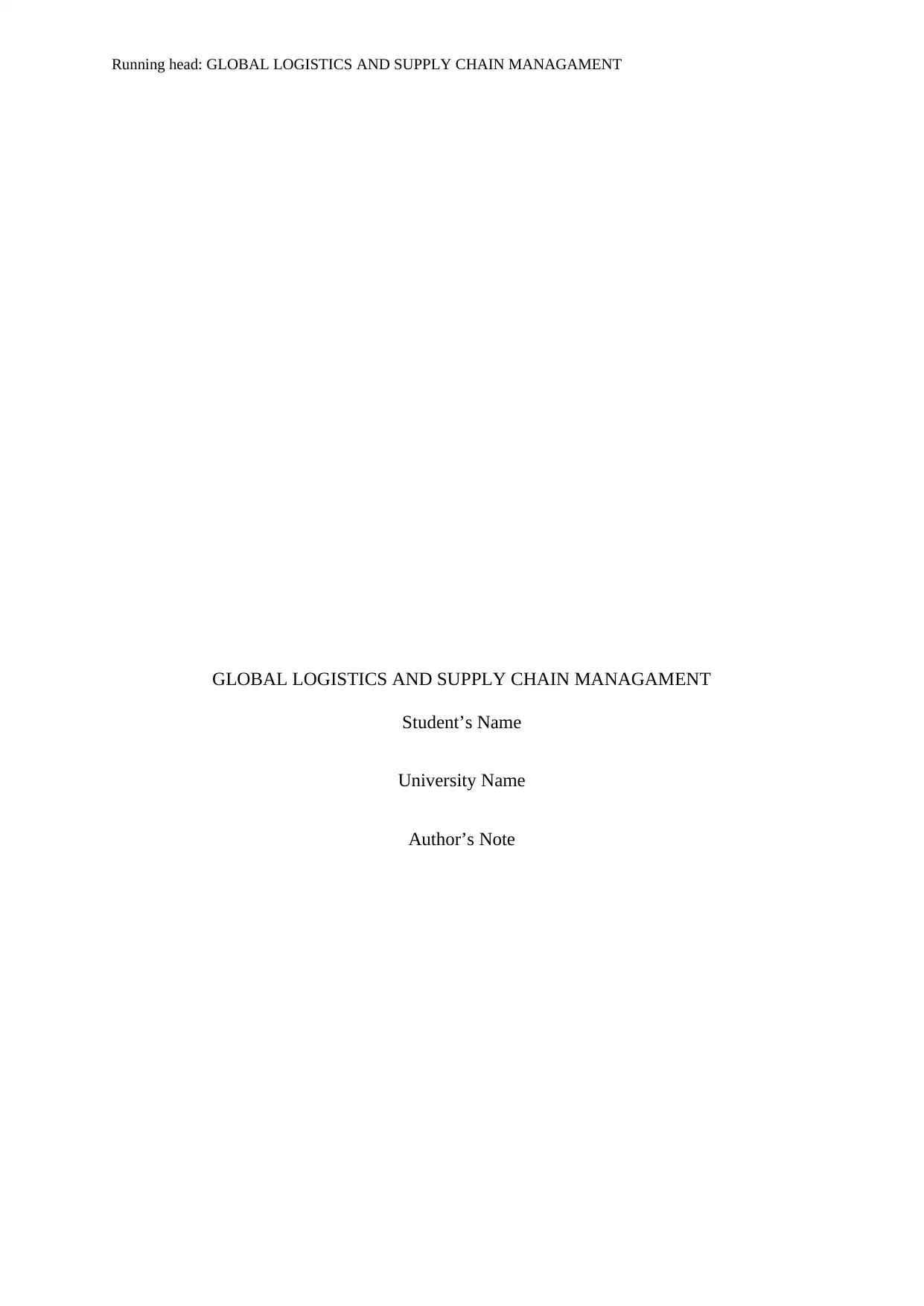
Running head: GLOBAL LOGISTICS AND SUPPLY CHAIN MANAGAMENT
GLOBAL LOGISTICS AND SUPPLY CHAIN MANAGAMENT
Student’s Name
University Name
Author’s Note
GLOBAL LOGISTICS AND SUPPLY CHAIN MANAGAMENT
Student’s Name
University Name
Author’s Note
Paraphrase This Document
Need a fresh take? Get an instant paraphrase of this document with our AI Paraphraser
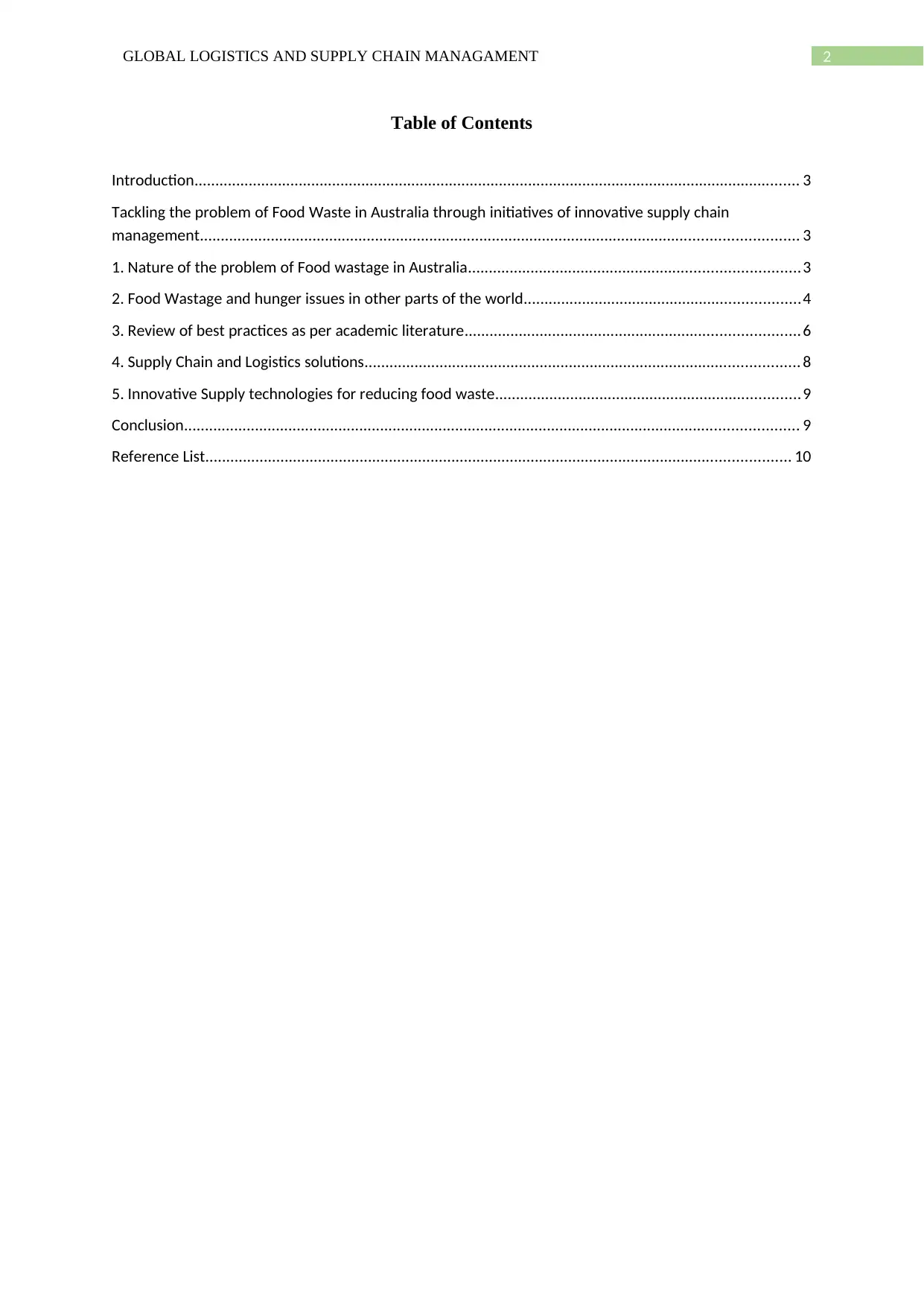
2GLOBAL LOGISTICS AND SUPPLY CHAIN MANAGAMENT
Table of Contents
Introduction................................................................................................................................................. 3
Tackling the problem of Food Waste in Australia through initiatives of innovative supply chain
management............................................................................................................................................... 3
1. Nature of the problem of Food wastage in Australia...............................................................................3
2. Food Wastage and hunger issues in other parts of the world..................................................................4
3. Review of best practices as per academic literature................................................................................6
4. Supply Chain and Logistics solutions........................................................................................................ 8
5. Innovative Supply technologies for reducing food waste.........................................................................9
Conclusion................................................................................................................................................... 9
Reference List............................................................................................................................................ 10
Table of Contents
Introduction................................................................................................................................................. 3
Tackling the problem of Food Waste in Australia through initiatives of innovative supply chain
management............................................................................................................................................... 3
1. Nature of the problem of Food wastage in Australia...............................................................................3
2. Food Wastage and hunger issues in other parts of the world..................................................................4
3. Review of best practices as per academic literature................................................................................6
4. Supply Chain and Logistics solutions........................................................................................................ 8
5. Innovative Supply technologies for reducing food waste.........................................................................9
Conclusion................................................................................................................................................... 9
Reference List............................................................................................................................................ 10
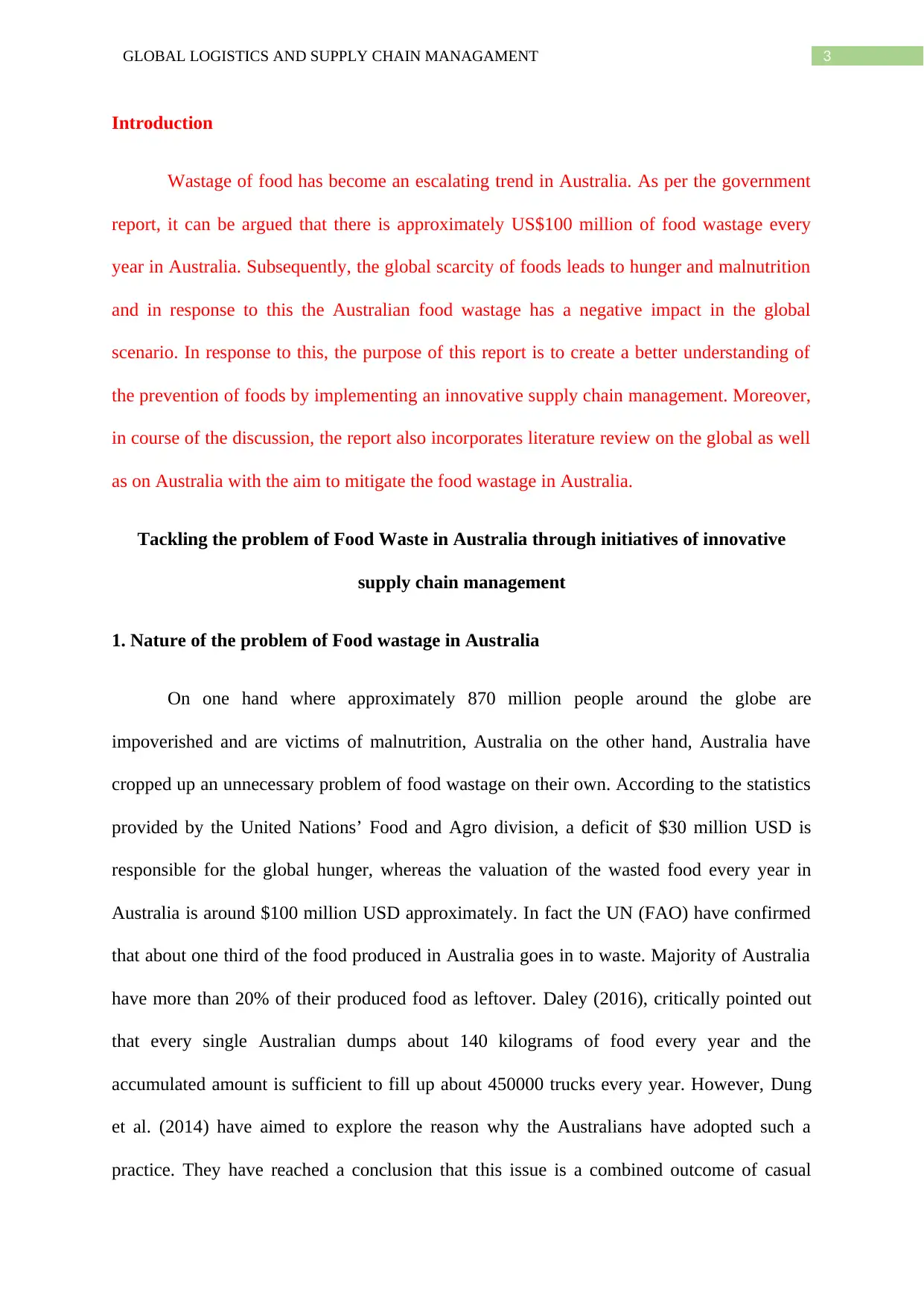
3GLOBAL LOGISTICS AND SUPPLY CHAIN MANAGAMENT
Introduction
Wastage of food has become an escalating trend in Australia. As per the government
report, it can be argued that there is approximately US$100 million of food wastage every
year in Australia. Subsequently, the global scarcity of foods leads to hunger and malnutrition
and in response to this the Australian food wastage has a negative impact in the global
scenario. In response to this, the purpose of this report is to create a better understanding of
the prevention of foods by implementing an innovative supply chain management. Moreover,
in course of the discussion, the report also incorporates literature review on the global as well
as on Australia with the aim to mitigate the food wastage in Australia.
Tackling the problem of Food Waste in Australia through initiatives of innovative
supply chain management
1. Nature of the problem of Food wastage in Australia
On one hand where approximately 870 million people around the globe are
impoverished and are victims of malnutrition, Australia on the other hand, Australia have
cropped up an unnecessary problem of food wastage on their own. According to the statistics
provided by the United Nations’ Food and Agro division, a deficit of $30 million USD is
responsible for the global hunger, whereas the valuation of the wasted food every year in
Australia is around $100 million USD approximately. In fact the UN (FAO) have confirmed
that about one third of the food produced in Australia goes in to waste. Majority of Australia
have more than 20% of their produced food as leftover. Daley (2016), critically pointed out
that every single Australian dumps about 140 kilograms of food every year and the
accumulated amount is sufficient to fill up about 450000 trucks every year. However, Dung
et al. (2014) have aimed to explore the reason why the Australians have adopted such a
practice. They have reached a conclusion that this issue is a combined outcome of casual
Introduction
Wastage of food has become an escalating trend in Australia. As per the government
report, it can be argued that there is approximately US$100 million of food wastage every
year in Australia. Subsequently, the global scarcity of foods leads to hunger and malnutrition
and in response to this the Australian food wastage has a negative impact in the global
scenario. In response to this, the purpose of this report is to create a better understanding of
the prevention of foods by implementing an innovative supply chain management. Moreover,
in course of the discussion, the report also incorporates literature review on the global as well
as on Australia with the aim to mitigate the food wastage in Australia.
Tackling the problem of Food Waste in Australia through initiatives of innovative
supply chain management
1. Nature of the problem of Food wastage in Australia
On one hand where approximately 870 million people around the globe are
impoverished and are victims of malnutrition, Australia on the other hand, Australia have
cropped up an unnecessary problem of food wastage on their own. According to the statistics
provided by the United Nations’ Food and Agro division, a deficit of $30 million USD is
responsible for the global hunger, whereas the valuation of the wasted food every year in
Australia is around $100 million USD approximately. In fact the UN (FAO) have confirmed
that about one third of the food produced in Australia goes in to waste. Majority of Australia
have more than 20% of their produced food as leftover. Daley (2016), critically pointed out
that every single Australian dumps about 140 kilograms of food every year and the
accumulated amount is sufficient to fill up about 450000 trucks every year. However, Dung
et al. (2014) have aimed to explore the reason why the Australians have adopted such a
practice. They have reached a conclusion that this issue is a combined outcome of casual
⊘ This is a preview!⊘
Do you want full access?
Subscribe today to unlock all pages.

Trusted by 1+ million students worldwide
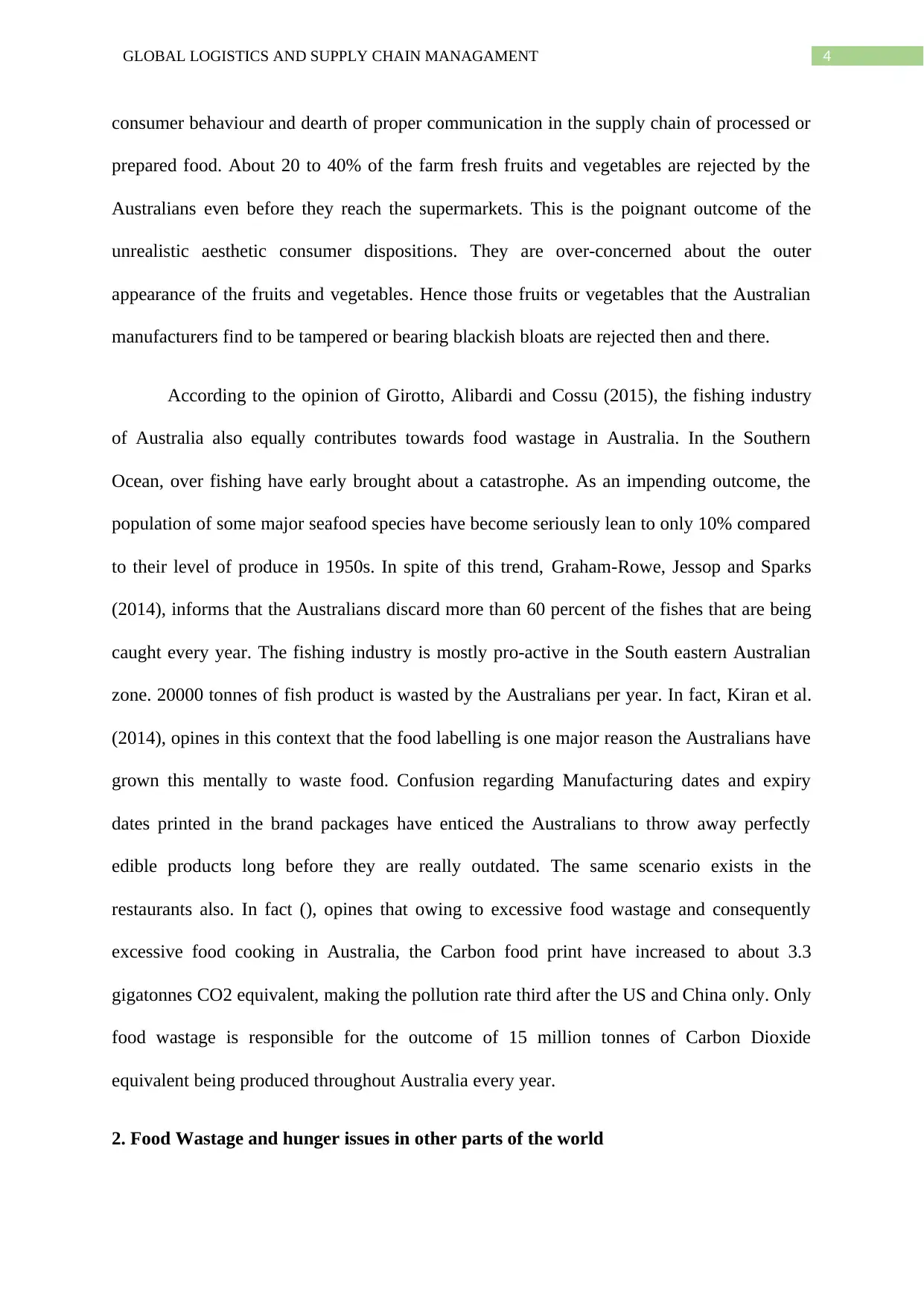
4GLOBAL LOGISTICS AND SUPPLY CHAIN MANAGAMENT
consumer behaviour and dearth of proper communication in the supply chain of processed or
prepared food. About 20 to 40% of the farm fresh fruits and vegetables are rejected by the
Australians even before they reach the supermarkets. This is the poignant outcome of the
unrealistic aesthetic consumer dispositions. They are over-concerned about the outer
appearance of the fruits and vegetables. Hence those fruits or vegetables that the Australian
manufacturers find to be tampered or bearing blackish bloats are rejected then and there.
According to the opinion of Girotto, Alibardi and Cossu (2015), the fishing industry
of Australia also equally contributes towards food wastage in Australia. In the Southern
Ocean, over fishing have early brought about a catastrophe. As an impending outcome, the
population of some major seafood species have become seriously lean to only 10% compared
to their level of produce in 1950s. In spite of this trend, Graham-Rowe, Jessop and Sparks
(2014), informs that the Australians discard more than 60 percent of the fishes that are being
caught every year. The fishing industry is mostly pro-active in the South eastern Australian
zone. 20000 tonnes of fish product is wasted by the Australians per year. In fact, Kiran et al.
(2014), opines in this context that the food labelling is one major reason the Australians have
grown this mentally to waste food. Confusion regarding Manufacturing dates and expiry
dates printed in the brand packages have enticed the Australians to throw away perfectly
edible products long before they are really outdated. The same scenario exists in the
restaurants also. In fact (), opines that owing to excessive food wastage and consequently
excessive food cooking in Australia, the Carbon food print have increased to about 3.3
gigatonnes CO2 equivalent, making the pollution rate third after the US and China only. Only
food wastage is responsible for the outcome of 15 million tonnes of Carbon Dioxide
equivalent being produced throughout Australia every year.
2. Food Wastage and hunger issues in other parts of the world
consumer behaviour and dearth of proper communication in the supply chain of processed or
prepared food. About 20 to 40% of the farm fresh fruits and vegetables are rejected by the
Australians even before they reach the supermarkets. This is the poignant outcome of the
unrealistic aesthetic consumer dispositions. They are over-concerned about the outer
appearance of the fruits and vegetables. Hence those fruits or vegetables that the Australian
manufacturers find to be tampered or bearing blackish bloats are rejected then and there.
According to the opinion of Girotto, Alibardi and Cossu (2015), the fishing industry
of Australia also equally contributes towards food wastage in Australia. In the Southern
Ocean, over fishing have early brought about a catastrophe. As an impending outcome, the
population of some major seafood species have become seriously lean to only 10% compared
to their level of produce in 1950s. In spite of this trend, Graham-Rowe, Jessop and Sparks
(2014), informs that the Australians discard more than 60 percent of the fishes that are being
caught every year. The fishing industry is mostly pro-active in the South eastern Australian
zone. 20000 tonnes of fish product is wasted by the Australians per year. In fact, Kiran et al.
(2014), opines in this context that the food labelling is one major reason the Australians have
grown this mentally to waste food. Confusion regarding Manufacturing dates and expiry
dates printed in the brand packages have enticed the Australians to throw away perfectly
edible products long before they are really outdated. The same scenario exists in the
restaurants also. In fact (), opines that owing to excessive food wastage and consequently
excessive food cooking in Australia, the Carbon food print have increased to about 3.3
gigatonnes CO2 equivalent, making the pollution rate third after the US and China only. Only
food wastage is responsible for the outcome of 15 million tonnes of Carbon Dioxide
equivalent being produced throughout Australia every year.
2. Food Wastage and hunger issues in other parts of the world
Paraphrase This Document
Need a fresh take? Get an instant paraphrase of this document with our AI Paraphraser
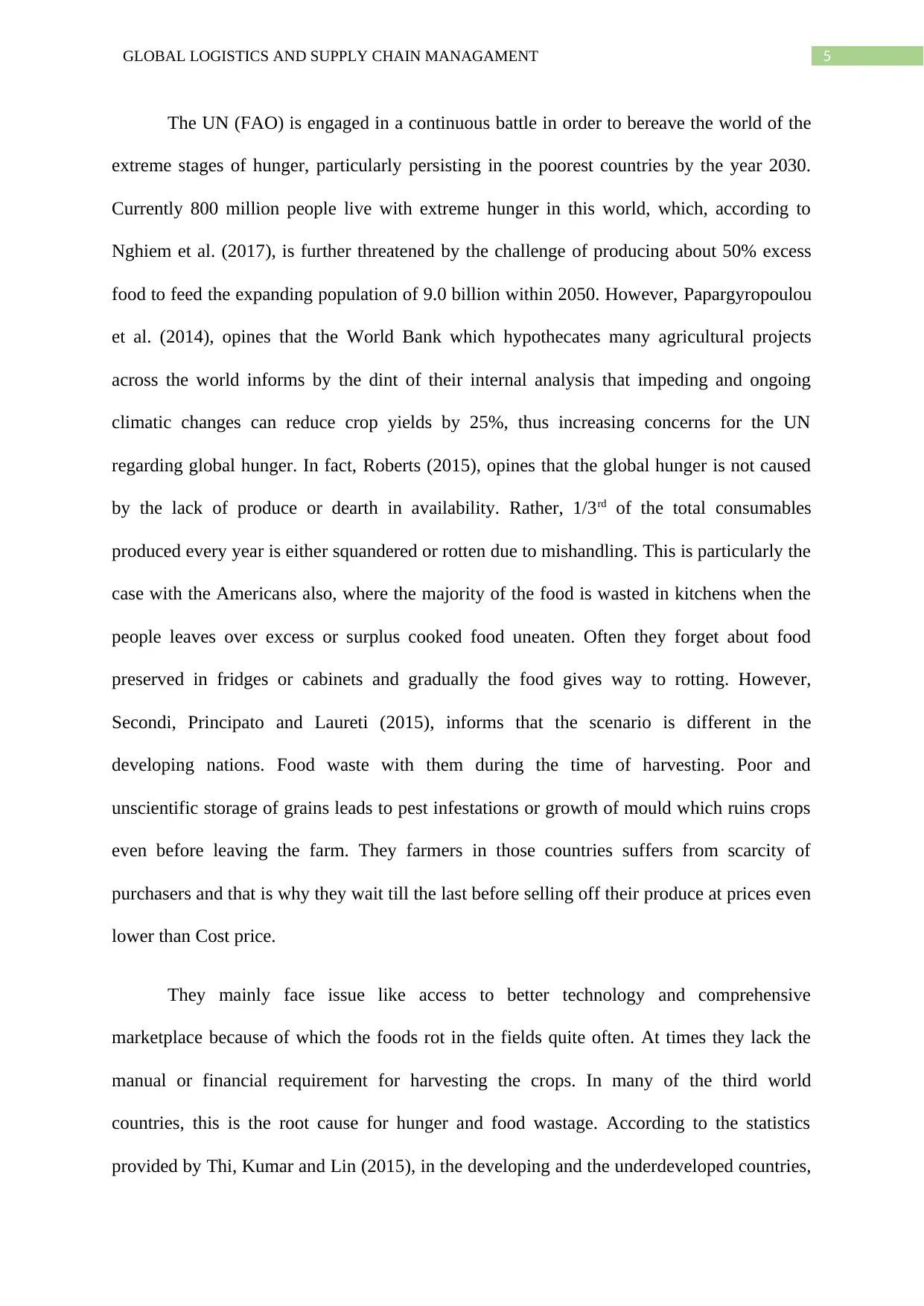
5GLOBAL LOGISTICS AND SUPPLY CHAIN MANAGAMENT
The UN (FAO) is engaged in a continuous battle in order to bereave the world of the
extreme stages of hunger, particularly persisting in the poorest countries by the year 2030.
Currently 800 million people live with extreme hunger in this world, which, according to
Nghiem et al. (2017), is further threatened by the challenge of producing about 50% excess
food to feed the expanding population of 9.0 billion within 2050. However, Papargyropoulou
et al. (2014), opines that the World Bank which hypothecates many agricultural projects
across the world informs by the dint of their internal analysis that impeding and ongoing
climatic changes can reduce crop yields by 25%, thus increasing concerns for the UN
regarding global hunger. In fact, Roberts (2015), opines that the global hunger is not caused
by the lack of produce or dearth in availability. Rather, 1/3rd of the total consumables
produced every year is either squandered or rotten due to mishandling. This is particularly the
case with the Americans also, where the majority of the food is wasted in kitchens when the
people leaves over excess or surplus cooked food uneaten. Often they forget about food
preserved in fridges or cabinets and gradually the food gives way to rotting. However,
Secondi, Principato and Laureti (2015), informs that the scenario is different in the
developing nations. Food waste with them during the time of harvesting. Poor and
unscientific storage of grains leads to pest infestations or growth of mould which ruins crops
even before leaving the farm. They farmers in those countries suffers from scarcity of
purchasers and that is why they wait till the last before selling off their produce at prices even
lower than Cost price.
They mainly face issue like access to better technology and comprehensive
marketplace because of which the foods rot in the fields quite often. At times they lack the
manual or financial requirement for harvesting the crops. In many of the third world
countries, this is the root cause for hunger and food wastage. According to the statistics
provided by Thi, Kumar and Lin (2015), in the developing and the underdeveloped countries,
The UN (FAO) is engaged in a continuous battle in order to bereave the world of the
extreme stages of hunger, particularly persisting in the poorest countries by the year 2030.
Currently 800 million people live with extreme hunger in this world, which, according to
Nghiem et al. (2017), is further threatened by the challenge of producing about 50% excess
food to feed the expanding population of 9.0 billion within 2050. However, Papargyropoulou
et al. (2014), opines that the World Bank which hypothecates many agricultural projects
across the world informs by the dint of their internal analysis that impeding and ongoing
climatic changes can reduce crop yields by 25%, thus increasing concerns for the UN
regarding global hunger. In fact, Roberts (2015), opines that the global hunger is not caused
by the lack of produce or dearth in availability. Rather, 1/3rd of the total consumables
produced every year is either squandered or rotten due to mishandling. This is particularly the
case with the Americans also, where the majority of the food is wasted in kitchens when the
people leaves over excess or surplus cooked food uneaten. Often they forget about food
preserved in fridges or cabinets and gradually the food gives way to rotting. However,
Secondi, Principato and Laureti (2015), informs that the scenario is different in the
developing nations. Food waste with them during the time of harvesting. Poor and
unscientific storage of grains leads to pest infestations or growth of mould which ruins crops
even before leaving the farm. They farmers in those countries suffers from scarcity of
purchasers and that is why they wait till the last before selling off their produce at prices even
lower than Cost price.
They mainly face issue like access to better technology and comprehensive
marketplace because of which the foods rot in the fields quite often. At times they lack the
manual or financial requirement for harvesting the crops. In many of the third world
countries, this is the root cause for hunger and food wastage. According to the statistics
provided by Thi, Kumar and Lin (2015), in the developing and the underdeveloped countries,
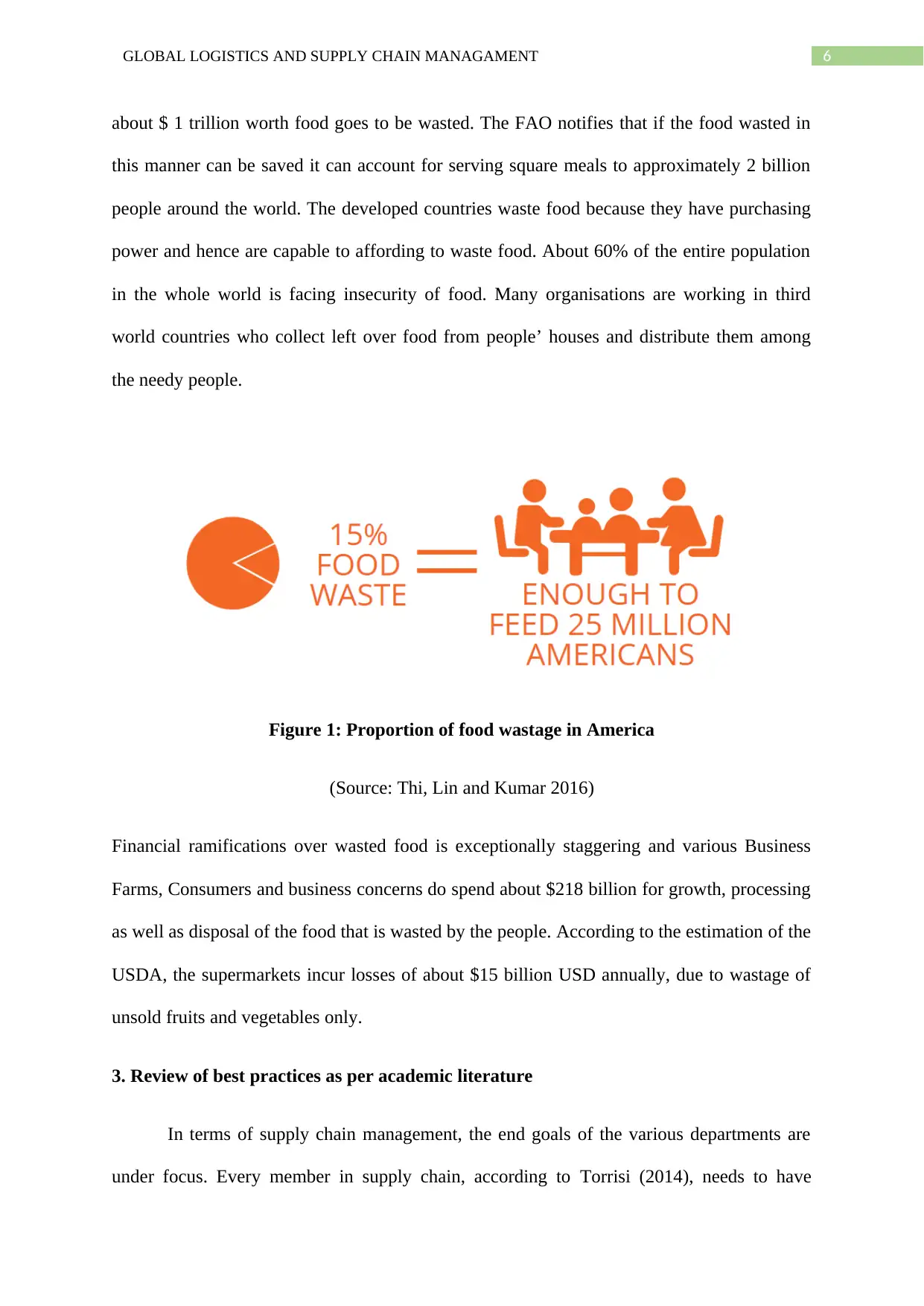
6GLOBAL LOGISTICS AND SUPPLY CHAIN MANAGAMENT
about $ 1 trillion worth food goes to be wasted. The FAO notifies that if the food wasted in
this manner can be saved it can account for serving square meals to approximately 2 billion
people around the world. The developed countries waste food because they have purchasing
power and hence are capable to affording to waste food. About 60% of the entire population
in the whole world is facing insecurity of food. Many organisations are working in third
world countries who collect left over food from people’ houses and distribute them among
the needy people.
Figure 1: Proportion of food wastage in America
(Source: Thi, Lin and Kumar 2016)
Financial ramifications over wasted food is exceptionally staggering and various Business
Farms, Consumers and business concerns do spend about $218 billion for growth, processing
as well as disposal of the food that is wasted by the people. According to the estimation of the
USDA, the supermarkets incur losses of about $15 billion USD annually, due to wastage of
unsold fruits and vegetables only.
3. Review of best practices as per academic literature
In terms of supply chain management, the end goals of the various departments are
under focus. Every member in supply chain, according to Torrisi (2014), needs to have
about $ 1 trillion worth food goes to be wasted. The FAO notifies that if the food wasted in
this manner can be saved it can account for serving square meals to approximately 2 billion
people around the world. The developed countries waste food because they have purchasing
power and hence are capable to affording to waste food. About 60% of the entire population
in the whole world is facing insecurity of food. Many organisations are working in third
world countries who collect left over food from people’ houses and distribute them among
the needy people.
Figure 1: Proportion of food wastage in America
(Source: Thi, Lin and Kumar 2016)
Financial ramifications over wasted food is exceptionally staggering and various Business
Farms, Consumers and business concerns do spend about $218 billion for growth, processing
as well as disposal of the food that is wasted by the people. According to the estimation of the
USDA, the supermarkets incur losses of about $15 billion USD annually, due to wastage of
unsold fruits and vegetables only.
3. Review of best practices as per academic literature
In terms of supply chain management, the end goals of the various departments are
under focus. Every member in supply chain, according to Torrisi (2014), needs to have
⊘ This is a preview!⊘
Do you want full access?
Subscribe today to unlock all pages.

Trusted by 1+ million students worldwide
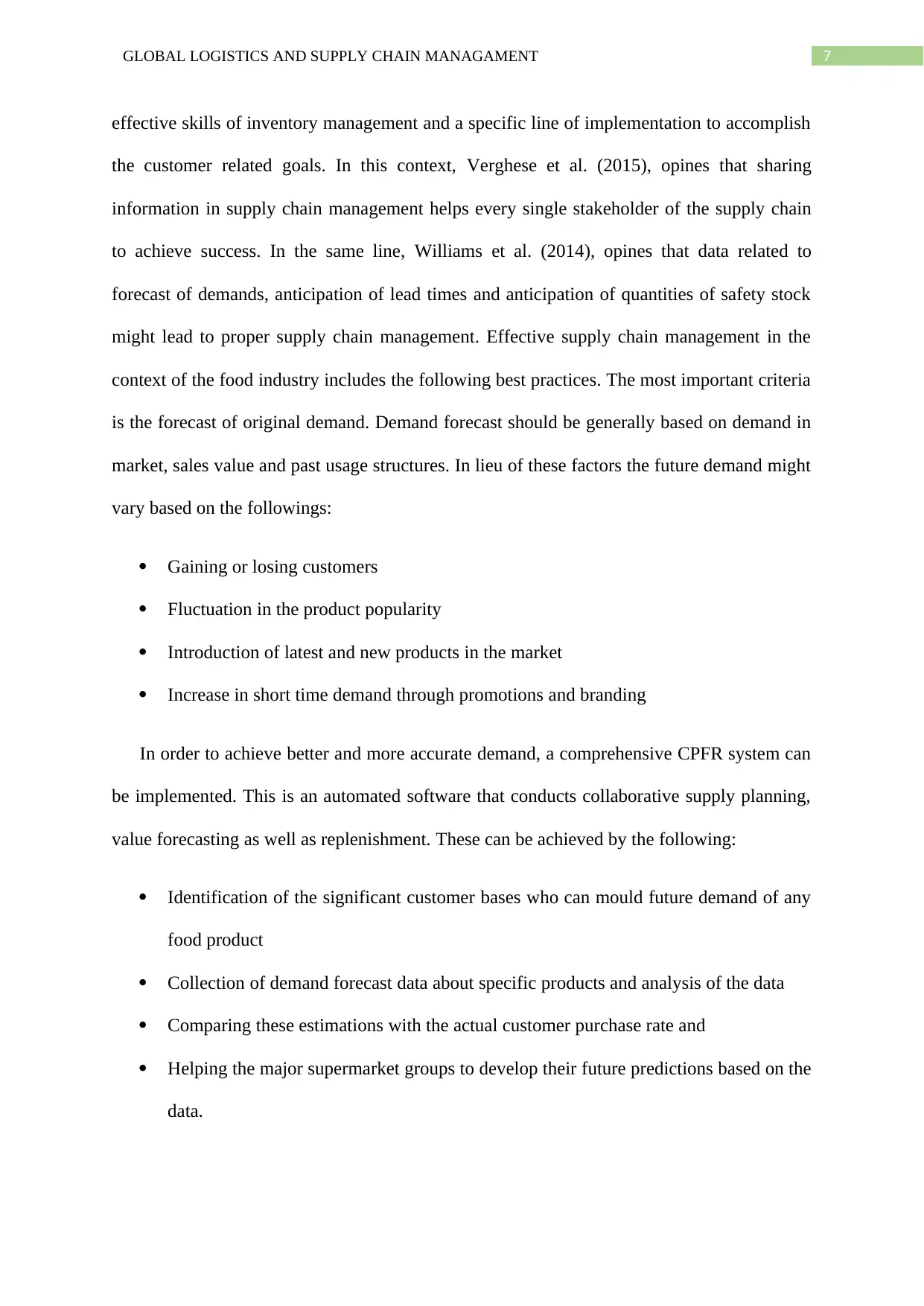
7GLOBAL LOGISTICS AND SUPPLY CHAIN MANAGAMENT
effective skills of inventory management and a specific line of implementation to accomplish
the customer related goals. In this context, Verghese et al. (2015), opines that sharing
information in supply chain management helps every single stakeholder of the supply chain
to achieve success. In the same line, Williams et al. (2014), opines that data related to
forecast of demands, anticipation of lead times and anticipation of quantities of safety stock
might lead to proper supply chain management. Effective supply chain management in the
context of the food industry includes the following best practices. The most important criteria
is the forecast of original demand. Demand forecast should be generally based on demand in
market, sales value and past usage structures. In lieu of these factors the future demand might
vary based on the followings:
Gaining or losing customers
Fluctuation in the product popularity
Introduction of latest and new products in the market
Increase in short time demand through promotions and branding
In order to achieve better and more accurate demand, a comprehensive CPFR system can
be implemented. This is an automated software that conducts collaborative supply planning,
value forecasting as well as replenishment. These can be achieved by the following:
Identification of the significant customer bases who can mould future demand of any
food product
Collection of demand forecast data about specific products and analysis of the data
Comparing these estimations with the actual customer purchase rate and
Helping the major supermarket groups to develop their future predictions based on the
data.
effective skills of inventory management and a specific line of implementation to accomplish
the customer related goals. In this context, Verghese et al. (2015), opines that sharing
information in supply chain management helps every single stakeholder of the supply chain
to achieve success. In the same line, Williams et al. (2014), opines that data related to
forecast of demands, anticipation of lead times and anticipation of quantities of safety stock
might lead to proper supply chain management. Effective supply chain management in the
context of the food industry includes the following best practices. The most important criteria
is the forecast of original demand. Demand forecast should be generally based on demand in
market, sales value and past usage structures. In lieu of these factors the future demand might
vary based on the followings:
Gaining or losing customers
Fluctuation in the product popularity
Introduction of latest and new products in the market
Increase in short time demand through promotions and branding
In order to achieve better and more accurate demand, a comprehensive CPFR system can
be implemented. This is an automated software that conducts collaborative supply planning,
value forecasting as well as replenishment. These can be achieved by the following:
Identification of the significant customer bases who can mould future demand of any
food product
Collection of demand forecast data about specific products and analysis of the data
Comparing these estimations with the actual customer purchase rate and
Helping the major supermarket groups to develop their future predictions based on the
data.
Paraphrase This Document
Need a fresh take? Get an instant paraphrase of this document with our AI Paraphraser
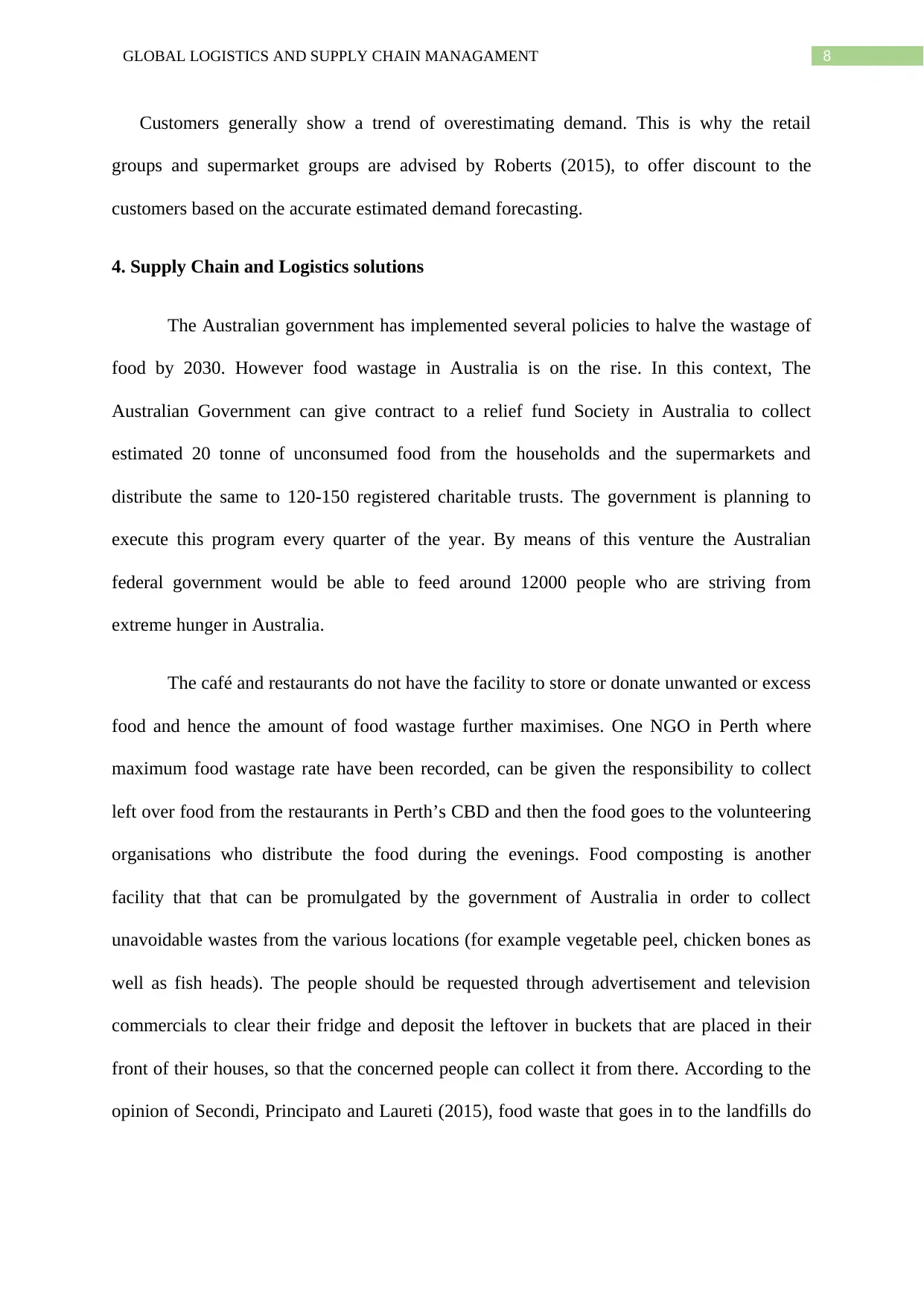
8GLOBAL LOGISTICS AND SUPPLY CHAIN MANAGAMENT
Customers generally show a trend of overestimating demand. This is why the retail
groups and supermarket groups are advised by Roberts (2015), to offer discount to the
customers based on the accurate estimated demand forecasting.
4. Supply Chain and Logistics solutions
The Australian government has implemented several policies to halve the wastage of
food by 2030. However food wastage in Australia is on the rise. In this context, The
Australian Government can give contract to a relief fund Society in Australia to collect
estimated 20 tonne of unconsumed food from the households and the supermarkets and
distribute the same to 120-150 registered charitable trusts. The government is planning to
execute this program every quarter of the year. By means of this venture the Australian
federal government would be able to feed around 12000 people who are striving from
extreme hunger in Australia.
The café and restaurants do not have the facility to store or donate unwanted or excess
food and hence the amount of food wastage further maximises. One NGO in Perth where
maximum food wastage rate have been recorded, can be given the responsibility to collect
left over food from the restaurants in Perth’s CBD and then the food goes to the volunteering
organisations who distribute the food during the evenings. Food composting is another
facility that that can be promulgated by the government of Australia in order to collect
unavoidable wastes from the various locations (for example vegetable peel, chicken bones as
well as fish heads). The people should be requested through advertisement and television
commercials to clear their fridge and deposit the leftover in buckets that are placed in their
front of their houses, so that the concerned people can collect it from there. According to the
opinion of Secondi, Principato and Laureti (2015), food waste that goes in to the landfills do
Customers generally show a trend of overestimating demand. This is why the retail
groups and supermarket groups are advised by Roberts (2015), to offer discount to the
customers based on the accurate estimated demand forecasting.
4. Supply Chain and Logistics solutions
The Australian government has implemented several policies to halve the wastage of
food by 2030. However food wastage in Australia is on the rise. In this context, The
Australian Government can give contract to a relief fund Society in Australia to collect
estimated 20 tonne of unconsumed food from the households and the supermarkets and
distribute the same to 120-150 registered charitable trusts. The government is planning to
execute this program every quarter of the year. By means of this venture the Australian
federal government would be able to feed around 12000 people who are striving from
extreme hunger in Australia.
The café and restaurants do not have the facility to store or donate unwanted or excess
food and hence the amount of food wastage further maximises. One NGO in Perth where
maximum food wastage rate have been recorded, can be given the responsibility to collect
left over food from the restaurants in Perth’s CBD and then the food goes to the volunteering
organisations who distribute the food during the evenings. Food composting is another
facility that that can be promulgated by the government of Australia in order to collect
unavoidable wastes from the various locations (for example vegetable peel, chicken bones as
well as fish heads). The people should be requested through advertisement and television
commercials to clear their fridge and deposit the leftover in buckets that are placed in their
front of their houses, so that the concerned people can collect it from there. According to the
opinion of Secondi, Principato and Laureti (2015), food waste that goes in to the landfills do
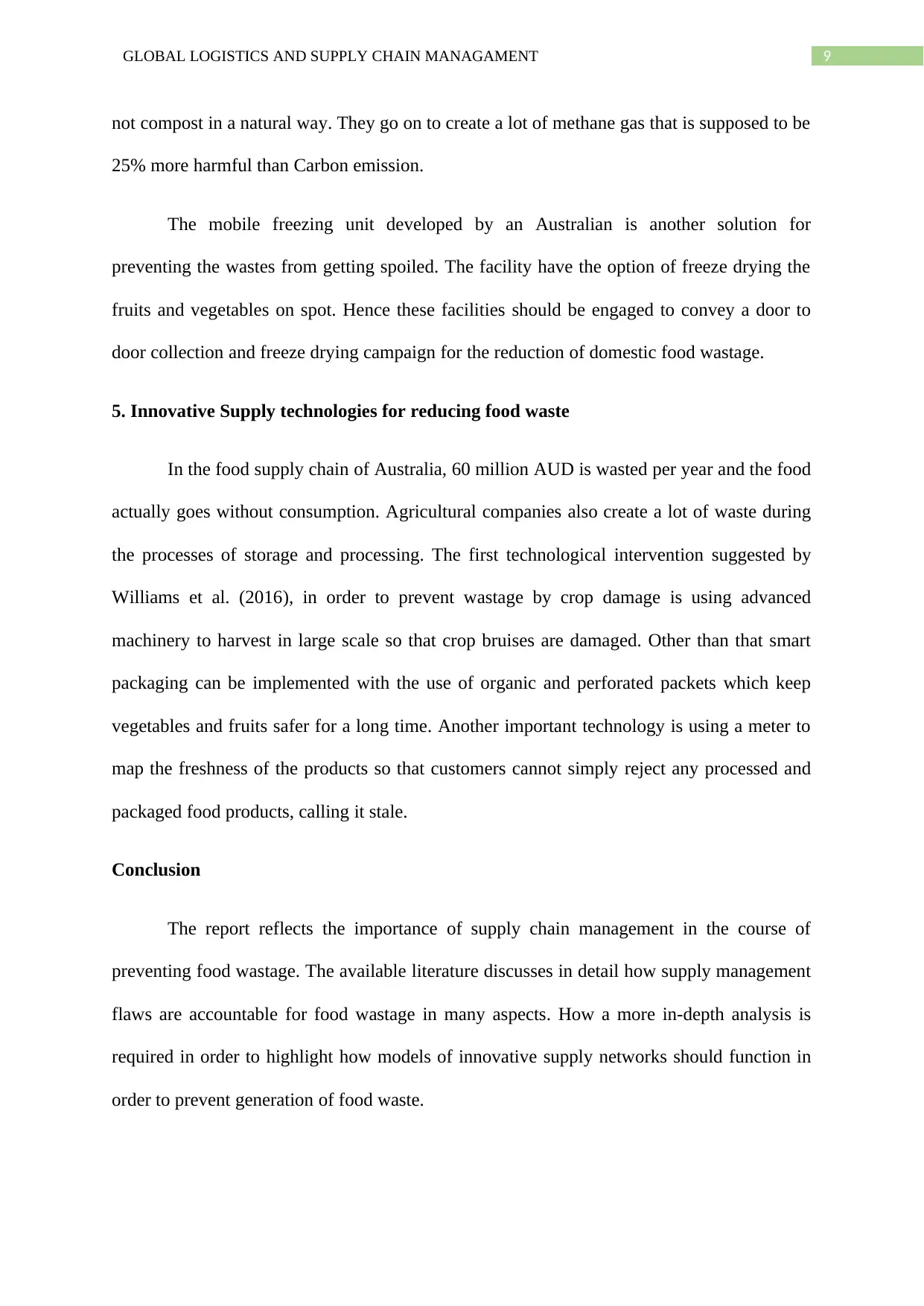
9GLOBAL LOGISTICS AND SUPPLY CHAIN MANAGAMENT
not compost in a natural way. They go on to create a lot of methane gas that is supposed to be
25% more harmful than Carbon emission.
The mobile freezing unit developed by an Australian is another solution for
preventing the wastes from getting spoiled. The facility have the option of freeze drying the
fruits and vegetables on spot. Hence these facilities should be engaged to convey a door to
door collection and freeze drying campaign for the reduction of domestic food wastage.
5. Innovative Supply technologies for reducing food waste
In the food supply chain of Australia, 60 million AUD is wasted per year and the food
actually goes without consumption. Agricultural companies also create a lot of waste during
the processes of storage and processing. The first technological intervention suggested by
Williams et al. (2016), in order to prevent wastage by crop damage is using advanced
machinery to harvest in large scale so that crop bruises are damaged. Other than that smart
packaging can be implemented with the use of organic and perforated packets which keep
vegetables and fruits safer for a long time. Another important technology is using a meter to
map the freshness of the products so that customers cannot simply reject any processed and
packaged food products, calling it stale.
Conclusion
The report reflects the importance of supply chain management in the course of
preventing food wastage. The available literature discusses in detail how supply management
flaws are accountable for food wastage in many aspects. How a more in-depth analysis is
required in order to highlight how models of innovative supply networks should function in
order to prevent generation of food waste.
not compost in a natural way. They go on to create a lot of methane gas that is supposed to be
25% more harmful than Carbon emission.
The mobile freezing unit developed by an Australian is another solution for
preventing the wastes from getting spoiled. The facility have the option of freeze drying the
fruits and vegetables on spot. Hence these facilities should be engaged to convey a door to
door collection and freeze drying campaign for the reduction of domestic food wastage.
5. Innovative Supply technologies for reducing food waste
In the food supply chain of Australia, 60 million AUD is wasted per year and the food
actually goes without consumption. Agricultural companies also create a lot of waste during
the processes of storage and processing. The first technological intervention suggested by
Williams et al. (2016), in order to prevent wastage by crop damage is using advanced
machinery to harvest in large scale so that crop bruises are damaged. Other than that smart
packaging can be implemented with the use of organic and perforated packets which keep
vegetables and fruits safer for a long time. Another important technology is using a meter to
map the freshness of the products so that customers cannot simply reject any processed and
packaged food products, calling it stale.
Conclusion
The report reflects the importance of supply chain management in the course of
preventing food wastage. The available literature discusses in detail how supply management
flaws are accountable for food wastage in many aspects. How a more in-depth analysis is
required in order to highlight how models of innovative supply networks should function in
order to prevent generation of food waste.
⊘ This is a preview!⊘
Do you want full access?
Subscribe today to unlock all pages.

Trusted by 1+ million students worldwide

10GLOBAL LOGISTICS AND SUPPLY CHAIN MANAGAMENT
Reference List
Daley, T., 2016. Food waste-the new last frontier (food for thought). Waste+ Water
Management Australia, 42(6), p.45.
Dung, T.N.B., Sen, B., Chen, C.C., Kumar, G. and Lin, C.Y., 2014. Food waste to bioenergy
via anaerobic processes. Energy Procedia, 61, pp.307-312.
Girotto, F., Alibardi, L. and Cossu, R., 2015. Food waste generation and industrial uses: a
review. Waste management, 45, pp.32-41.
Graham-Rowe, E., Jessop, D.C. and Sparks, P., 2014. Identifying motivations and barriers to
minimising household food waste. Resources, conservation and recycling, 84, pp.15-23.
Kiran, E.U., Trzcinski, A.P., Ng, W.J. and Liu, Y., 2014. Bioconversion of food waste to
energy: a review. Fuel, 134, pp.389-399.
Nghiem, L.D., Koch, K., Bolzonella, D. and Drewes, J.E., 2017. Full scale co-digestion of
wastewater sludge and food waste: bottlenecks and possibilities. Renewable and Sustainable
Energy Reviews, 72, pp.354-362.
Papargyropoulou, E., Lozano, R., Steinberger, J.K., Wright, N. and bin Ujang, Z., 2014. The
food waste hierarchy as a framework for the management of food surplus and food
waste. Journal of Cleaner Production, 76, pp.106-115.
Roberts, D., 2015. Characterisation of chemical composition and energy content of green
waste and municipal solid waste from Greater Brisbane, Australia. Waste management, 41,
pp.12-19.
Secondi, L., Principato, L. and Laureti, T., 2015. Household food waste behaviour in EU-27
countries: A multilevel analysis. Food Policy, 56, pp.25-40.
Reference List
Daley, T., 2016. Food waste-the new last frontier (food for thought). Waste+ Water
Management Australia, 42(6), p.45.
Dung, T.N.B., Sen, B., Chen, C.C., Kumar, G. and Lin, C.Y., 2014. Food waste to bioenergy
via anaerobic processes. Energy Procedia, 61, pp.307-312.
Girotto, F., Alibardi, L. and Cossu, R., 2015. Food waste generation and industrial uses: a
review. Waste management, 45, pp.32-41.
Graham-Rowe, E., Jessop, D.C. and Sparks, P., 2014. Identifying motivations and barriers to
minimising household food waste. Resources, conservation and recycling, 84, pp.15-23.
Kiran, E.U., Trzcinski, A.P., Ng, W.J. and Liu, Y., 2014. Bioconversion of food waste to
energy: a review. Fuel, 134, pp.389-399.
Nghiem, L.D., Koch, K., Bolzonella, D. and Drewes, J.E., 2017. Full scale co-digestion of
wastewater sludge and food waste: bottlenecks and possibilities. Renewable and Sustainable
Energy Reviews, 72, pp.354-362.
Papargyropoulou, E., Lozano, R., Steinberger, J.K., Wright, N. and bin Ujang, Z., 2014. The
food waste hierarchy as a framework for the management of food surplus and food
waste. Journal of Cleaner Production, 76, pp.106-115.
Roberts, D., 2015. Characterisation of chemical composition and energy content of green
waste and municipal solid waste from Greater Brisbane, Australia. Waste management, 41,
pp.12-19.
Secondi, L., Principato, L. and Laureti, T., 2015. Household food waste behaviour in EU-27
countries: A multilevel analysis. Food Policy, 56, pp.25-40.
Paraphrase This Document
Need a fresh take? Get an instant paraphrase of this document with our AI Paraphraser
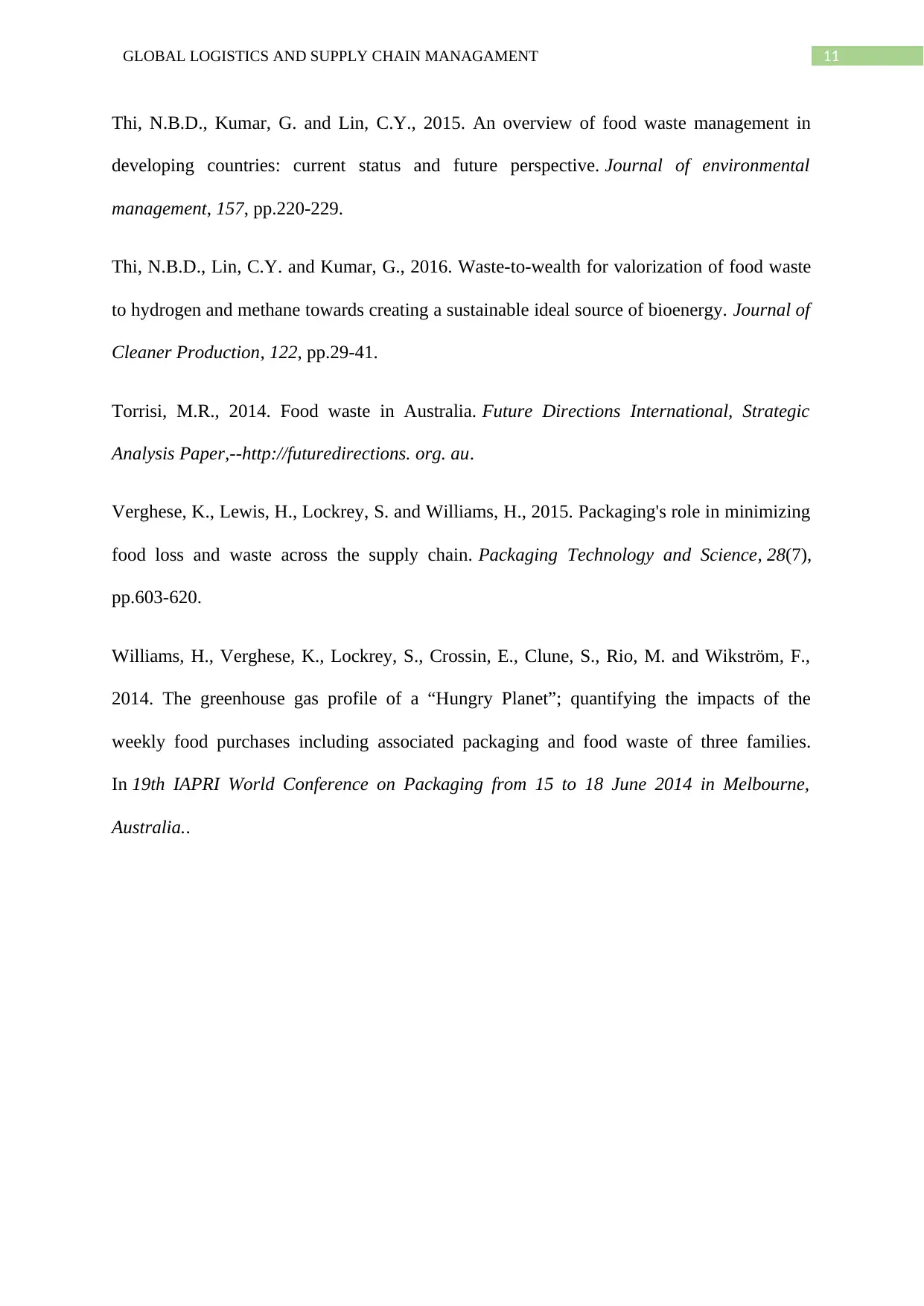
11GLOBAL LOGISTICS AND SUPPLY CHAIN MANAGAMENT
Thi, N.B.D., Kumar, G. and Lin, C.Y., 2015. An overview of food waste management in
developing countries: current status and future perspective. Journal of environmental
management, 157, pp.220-229.
Thi, N.B.D., Lin, C.Y. and Kumar, G., 2016. Waste-to-wealth for valorization of food waste
to hydrogen and methane towards creating a sustainable ideal source of bioenergy. Journal of
Cleaner Production, 122, pp.29-41.
Torrisi, M.R., 2014. Food waste in Australia. Future Directions International, Strategic
Analysis Paper,--http://futuredirections. org. au.
Verghese, K., Lewis, H., Lockrey, S. and Williams, H., 2015. Packaging's role in minimizing
food loss and waste across the supply chain. Packaging Technology and Science, 28(7),
pp.603-620.
Williams, H., Verghese, K., Lockrey, S., Crossin, E., Clune, S., Rio, M. and Wikström, F.,
2014. The greenhouse gas profile of a “Hungry Planet”; quantifying the impacts of the
weekly food purchases including associated packaging and food waste of three families.
In 19th IAPRI World Conference on Packaging from 15 to 18 June 2014 in Melbourne,
Australia..
Thi, N.B.D., Kumar, G. and Lin, C.Y., 2015. An overview of food waste management in
developing countries: current status and future perspective. Journal of environmental
management, 157, pp.220-229.
Thi, N.B.D., Lin, C.Y. and Kumar, G., 2016. Waste-to-wealth for valorization of food waste
to hydrogen and methane towards creating a sustainable ideal source of bioenergy. Journal of
Cleaner Production, 122, pp.29-41.
Torrisi, M.R., 2014. Food waste in Australia. Future Directions International, Strategic
Analysis Paper,--http://futuredirections. org. au.
Verghese, K., Lewis, H., Lockrey, S. and Williams, H., 2015. Packaging's role in minimizing
food loss and waste across the supply chain. Packaging Technology and Science, 28(7),
pp.603-620.
Williams, H., Verghese, K., Lockrey, S., Crossin, E., Clune, S., Rio, M. and Wikström, F.,
2014. The greenhouse gas profile of a “Hungry Planet”; quantifying the impacts of the
weekly food purchases including associated packaging and food waste of three families.
In 19th IAPRI World Conference on Packaging from 15 to 18 June 2014 in Melbourne,
Australia..
1 out of 11
Related Documents
Your All-in-One AI-Powered Toolkit for Academic Success.
+13062052269
info@desklib.com
Available 24*7 on WhatsApp / Email
![[object Object]](/_next/static/media/star-bottom.7253800d.svg)
Unlock your academic potential
Copyright © 2020–2025 A2Z Services. All Rights Reserved. Developed and managed by ZUCOL.





